Book contents
- Frontmatter
- Contents
- Preface
- Acknowledgments
- 1 Basic rules of writing
- 2 Comments on scientific language
- 3 Drafting the manuscript
- 4 Choosing a journal
- 5 Preparing a graph
- 6 Drawings
- 7 Figure legends
- 8 How to design tables
- 9 Title
- 10 Authors
- 11 Abstract
- 12 Introduction
- 13 Methods
- 14 Results
- 15 Discussion
- 16 Acknowledgments
- 17 References
- 18 Ph.D. and other doctoral theses
- 19 Letters and case reports
- 20 Numbers
- 21 Abbreviations
- 22 How to present statistical results
- 23 Typing
- 24 Dealing with editors and referees
- 25 Correcting proofs
- 26 Authors‘ responsibilities
- Literature needed on your desk
- Further reading
- Literature cited
- Index
11 - Abstract
Published online by Cambridge University Press: 05 June 2012
- Frontmatter
- Contents
- Preface
- Acknowledgments
- 1 Basic rules of writing
- 2 Comments on scientific language
- 3 Drafting the manuscript
- 4 Choosing a journal
- 5 Preparing a graph
- 6 Drawings
- 7 Figure legends
- 8 How to design tables
- 9 Title
- 10 Authors
- 11 Abstract
- 12 Introduction
- 13 Methods
- 14 Results
- 15 Discussion
- 16 Acknowledgments
- 17 References
- 18 Ph.D. and other doctoral theses
- 19 Letters and case reports
- 20 Numbers
- 21 Abbreviations
- 22 How to present statistical results
- 23 Typing
- 24 Dealing with editors and referees
- 25 Correcting proofs
- 26 Authors‘ responsibilities
- Literature needed on your desk
- Further reading
- Literature cited
- Index
Summary
By writing a working abstract at an early stage, you will provide yourself with a framework for the rest of the article. It will guide you in deciding what to include and what to omit, thus sparing you tedious rewriting. Then, when you have completed the paper, you can return to the working abstract and recast it in its final form.
Let us consider here what to include. In both types of abstract, the conventional (unstructured) and the formally structured, the same four basic sections are required: Background (including the purpose of the study), Methods, Results, and Conclusions
The conventional abstract
In the conventional abstract, the four basic components are not identified with explicit headings, which may explain why some authors miss out vital parts. In the worst instance, the abstract contains neither background nor conclusion. Many abstracts written in the conventional manner are uninformative and cause editors much unnecessary editorial trouble. The following abstract, quoted from an article in Contraception, commences directly with the method:
80 female Wistar rats were employed in this work. They were homogeneously divided into four groups….
Most journals reporting laboratory studies use the conventional abstract, and it is usually applied to Case Reports and Briel Communications. Clinical journals, however, often require a structured abstract for full-length papers.
The structured abstract
The structured abstract differs from the conventional abstract by having a heading for each section. Here is such an abstract of the classic The chromosome number of man by Tjio and Levan (1956).
- Type
- Chapter
- Information
- How to Write and Illustrate a Scientific Paper , pp. 58 - 60Publisher: Cambridge University PressPrint publication year: 2008
- 2
- Cited by



